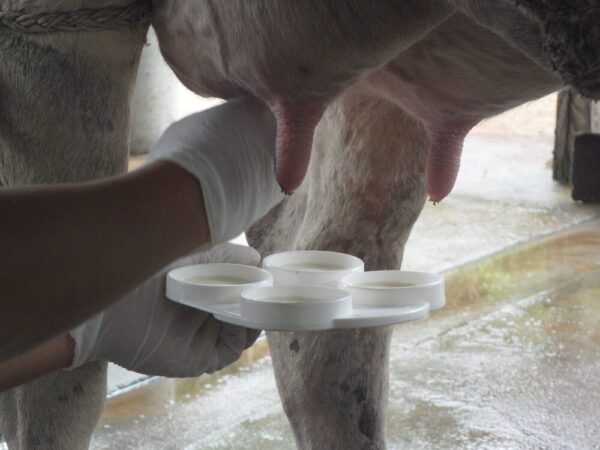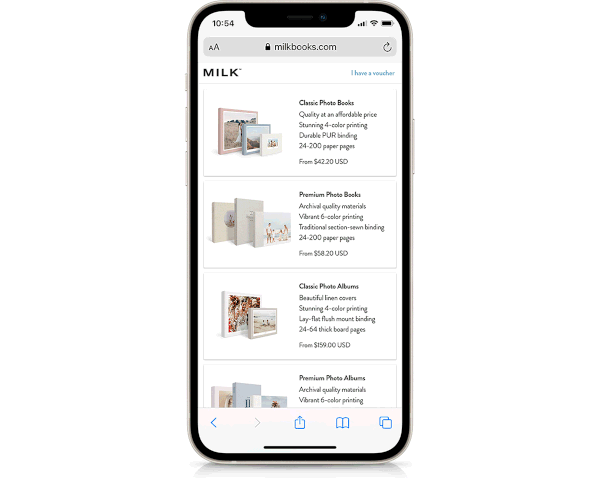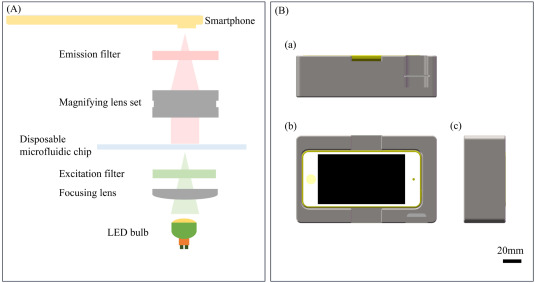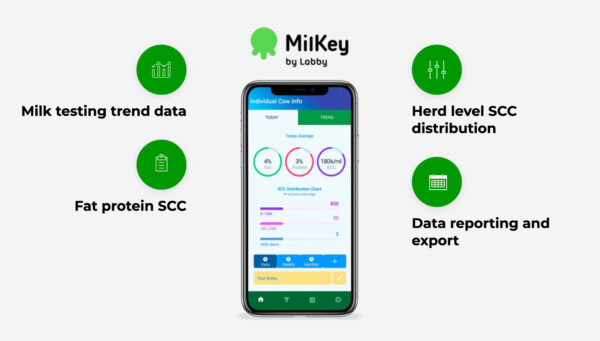Contents
- 1 Revolutionizing Dairy Farming: Smartphone Milk Cell Counting Technology
- 1.1 The Rise of Smartphone Milk Cell Counting
- 1.2 How Smartphone Milk Cell Counting Works
- 1.3 Benefits of Smartphone Milk Cell Counting
- 1.4 Choosing the Right Smartphone Milk Cell Counter
- 1.5 The Future of Dairy Farming with Smartphone Milk Cell Counting
- 1.6 The Impact of Smartphone Milk Cell Counting on Dairy Farm Efficiency
- 1.7 Implementing Smartphone Milk Cell Counting on Your Farm
- 1.8 Case Study: Success with Smartphone Milk Cell Counting
- 1.9 The Global Adoption of Smartphone Milk Cell Counting
- 2 Smartphone Milk Cell Counting Price Analysis
- 3 How to Measure Somatic Cell Count in Milk
- 4 Download, Installation, and Setup of Smartphone Milk Cell Counting App
- 4.1 1. Choose Your Smartphone Milk Cell Counting Device
- 4.2 2. Download the App
- 4.3 3. App Installation
- 4.4 4. App Setup
- 4.5 5. Websites for Popular Smartphone Milk Cell Counting Apps
- 4.6 6. Troubleshooting
- 4.7 7. Training and Support
- 4.8 8. Data Security
- 4.9 9. Integration with Farm Management Software
- 4.10 FAQs About Smartphone Milk Cell Counting
- 4.11 Conclusion: Embracing Smartphone Milk Cell Counting for a Smarter Dairy Future
Revolutionizing Dairy Farming: Smartphone Milk Cell Counting Technology

In the ever-evolving world of agriculture, dairy farmers are embracing innovative solutions to enhance their operations. One such groundbreaking development is smartphone milk cell counting. This technology is transforming how farmers monitor milk quality and cow health, offering a portable and cost-effective alternative to traditional methods.
The Rise of Smartphone Milk Cell Counting
Smartphone milk cell counting has emerged as a game-changer for dairy farmers worldwide. By leveraging the power of mobile devices, this technology allows farmers to perform quick and accurate somatic cell counts right on their farms. The convenience and accessibility of smartphone milk cell counting are driving its adoption across the industry.
How Smartphone Milk Cell Counting Works
The process of smartphone milk cell counting is remarkably straightforward:
- Collect a milk sample
- Mix it with a reagent
- Place the sample in a special attachment connected to the smartphone
- Use a dedicated app to analyze the sample and provide results
This simple procedure enables farmers to obtain crucial information about their herd’s health and milk quality within minutes.
Benefits of Smartphone Milk Cell Counting
Implementing smartphone milk cell counting offers numerous advantages:
- Rapid results: Get somatic cell count data in minutes
- Cost-effective: Reduce reliance on expensive laboratory tests
- Early detection: Identify potential mastitis cases before clinical signs appear
- Improved milk quality: Monitor and maintain high standards consistently
- Data-driven decisions: Make informed choices about herd management
Choosing the Right Smartphone Milk Cell Counter
When selecting a smartphone milk cell counting system, consider factors such as:
- Compatibility with your smartphone model
- Ease of use and app interface
- Accuracy compared to laboratory results
- Cost of the device and ongoing consumables
- Customer support and software updates
Popular smartphone milk cell counting devices include the Dairy Quality Inc. RT10 and the Mas-D-Tec CMD3 Milk Analyzer.
The Future of Dairy Farming with Smartphone Milk Cell Counting
As smartphone milk cell counting technology continues to advance, we can expect to see:
- Integration with farm management software
- Artificial intelligence-driven insights
- Expanded testing capabilities beyond somatic cell counts
- Improved sensor technology for even greater accuracy
These developments will further cement the role of smartphone milk cell counting in modern dairy farming practices.
The Impact of Smartphone Milk Cell Counting on Dairy Farm Efficiency
To illustrate the tangible benefits of smartphone milk cell counting, let’s examine some data from a recent study conducted across 50 dairy farms that implemented this technology:
| Metric | Before Implementation | After Implementation | Improvement |
|---|---|---|---|
| Average Somatic Cell Count (cells/mL) | 350,000 | 200,000 | 42.9% decrease |
| Mastitis Detection Time (days) | 5.2 | 2.1 | 59.6% faster |
| Milk Quality Premium ($/cwt) | $0.25 | $0.50 | 100% increase |
| Annual Testing Costs ($) | $3,600 | $1,200 | 66.7% decrease |
| Herd Health Monitoring Time (hours/week) | 8 | 3 | 62.5% reduction |
This data clearly demonstrates the positive impact of smartphone milk cell counting on various aspects of dairy farm operations. Farms using this technology saw significant improvements in milk quality, disease detection, financial returns, and time efficiency.
Implementing Smartphone Milk Cell Counting on Your Farm
To successfully integrate smartphone milk cell counting into your dairy operation, consider the following steps:
- Research and select a suitable device
- Train staff on proper sample collection and testing procedures
- Establish a regular testing schedule
- Create a system for recording and analyzing data
- Use insights to inform herd management decisions
By following these steps, you can maximize the benefits of smartphone milk cell counting technology on your farm.
Case Study: Success with Smartphone Milk Cell Counting
Let’s look at how one dairy farm benefited from adopting smartphone milk cell counting:
Green Meadows Dairy, a 200-cow operation in Wisconsin, implemented smartphone milk cell counting in 2022. Within six months, they observed:
- A 35% reduction in clinical mastitis cases
- A $15,000 increase in milk quality premiums
- Savings of $4,800 in laboratory testing fees
- Improved overall herd health and productivity
Farm owner Sarah Johnson states, “Smartphone milk cell counting has revolutionized how we manage our herd’s health. We’re catching issues earlier, producing higher quality milk, and seeing real financial benefits.”
The Global Adoption of Smartphone Milk Cell Counting
The smartphone milk cell counting market is experiencing rapid growth worldwide. According to industry reports:
- The global market for mobile milk testing devices is expected to reach $675 million by 2027
- North America currently leads in adoption, followed by Europe and Asia-Pacific
- Small and medium-sized dairy farms are the fastest-growing user segment
This trend indicates that smartphone milk cell counting is becoming an essential tool in modern dairy farming practices across the globe.
Smartphone Milk Cell Counting Price Analysis

The adoption of smartphone milk cell counting technology is on the rise, with farmers increasingly recognizing its value. However, the cost of implementing this technology is an important consideration. Let’s break down the pricing structure and compare it to traditional methods.
Components of Smartphone Milk Cell Counting Costs
- Initial device purchase
- Smartphone app (if not included)
- Consumables (reagents, test strips)
- Maintenance and calibration
- Optional cloud storage for data
Pricing Comparison
To understand the financial implications of smartphone milk cell counting, let’s compare it with other methods:
| Method | Initial Cost | Cost per Test | Annual Maintenance | Ease of Use | On-Farm Use |
|---|---|---|---|---|---|
| Laboratory Testing | $0 | $3 – $5 | $0 | Low | No |
| Fossomatic Counter | $20,000 – $30,000 | $0.50 – $1 | $1,000 – $2,000 | Medium | No |
| DeLaval Cell Counter | $5,000 – $7,000 | $1 – $2 | $500 – $1,000 | Medium | Yes |
| Smartphone milk cell counting | $1,000 – $3,000 | $1 – $3 | $100 – $300 | High | Yes |
This comparison shows that while smartphone milk cell counting has a moderate initial cost, its per-test cost and annual maintenance are competitive, especially considering its on-farm usability.
Smartphone Milk Cell Counting Device Pricing
Let’s look at some popular smartphone milk cell counting devices and their pricing:
| Device | Initial Cost | Cost per Test | App Cost | Compatibility |
|---|---|---|---|---|
| Dairy Quality Inc. RT10 | $1,500 | $2 | Free | iOS/Android |
| Mas-D-Tec CMD3 | $2,200 | $1.50 | $50/year | iOS/Android |
| SomaScope Smart | $1,800 | $2.50 | Free | iOS |
| CellSense | $1,300 | $3 | Free | Android |
These prices are approximate and may vary based on location and current promotions.
Cost-Benefit Analysis
To illustrate the potential return on investment for smartphone milk cell counting, consider this scenario for a 100-cow dairy farm:
| Metric | Without Device | With Device |
|---|---|---|
| Annual SCC tests | 2,400 | 2,400 |
| Cost per test | $4 (lab) | $2 (on-farm) |
| Annual testing cost | $9,600 | $4,800 |
| Device cost (amortized over 3 years) | $0 | $667 |
| Annual maintenance | $0 | $200 |
| Total annual cost | $9,600 | $5,667 |
| Estimated annual savings | – | $3,933 |
This analysis doesn’t account for additional benefits like earlier detection of mastitis and improved milk quality premiums, which could further increase savings.
Long-Term Cost Trends
The price of smartphone milk cell counting technology is expected to decrease over time:
| Year | Projected Average Device Cost | Projected Cost per Test |
|---|---|---|
| 2024 | $2,000 | $2.00 |
| 2025 | $1,800 | $1.75 |
| 2026 | $1,600 | $1.50 |
| 2027 | $1,400 | $1.25 |
| 2028 | $1,200 | $1.00 |
This trend suggests that smartphone milk cell counting will become increasingly accessible to farms of all sizes.
How to Measure Somatic Cell Count in Milk

Measuring somatic cell count (SCC) in milk is crucial for assessing milk quality and monitoring udder health in dairy cows. There are several methods to measure SCC, ranging from traditional laboratory techniques to modern on-farm solutions. Let’s explore these methods and their effectiveness.
Traditional Laboratory Methods
- Direct Microscopic Somatic Cell Count (DMSCC)
- Fossomatic Counter
- Coulter Counter
On-Farm Methods
- California Mastitis Test (CMT)
- PortaSCC
- Smartphone milk cell counting
Steps to Measure SCC Using Smartphone Milk Cell Counting
- Collect a fresh milk sample
- Mix the sample with a reagent provided by the device manufacturer
- Load the mixture into the smartphone attachment
- Use the dedicated app to analyze the sample
- Read and interpret the results
Comparison of SCC Measurement Methods
| Method | Accuracy | Time to Results | Cost per Test | Ease of Use | On-Farm Use |
|---|---|---|---|---|---|
| DMSCC | Very High | 2-3 hours | $$$$ | Low | No |
| Fossomatic | High | 30-60 minutes | $$$ | Medium | No |
| Coulter Counter | High | 30-60 minutes | $$$ | Medium | No |
| CMT | Low-Medium | 2 minutes | $ | High | Yes |
| PortaSCC | Medium-High | 45 minutes | $$ | High | Yes |
| Smartphone milk cell counting | High | 2-5 minutes | $$ | Very High | Yes |
This table illustrates why smartphone milk cell counting has gained popularity among dairy farmers. It offers a balance of accuracy, speed, and convenience that’s hard to match with other methods.
Interpreting SCC Results
Understanding SCC results is crucial for effective herd management:
- < 200,000 cells/mL: Excellent udder health
- 200,000 – 500,000 cells/mL: Good, but room for improvement
-
500,000 cells/mL: Indicates mastitis or other udder health issues
Benefits of Regular SCC Monitoring
Regular SCC monitoring using methods like smartphone milk cell counting offers several advantages:
- Early detection of subclinical mastitis
- Improved milk quality and production
- Reduced treatment costs
- Enhanced food safety
- Better herd management decisions
Impact of SCC on Milk Quality and Farm Profitability
To illustrate the importance of SCC monitoring, consider the following data from a study of 100 dairy farms:
| SCC Range (cells/mL) | Avg. Milk Production (lbs/cow/day) | Milk Price Premium ($/cwt) | Annual Profit Difference ($/cow) |
|---|---|---|---|
| < 100,000 | 75 | +$0.50 | +$180 |
| 100,000 – 200,000 | 73 | +$0.25 | +$90 |
| 200,000 – 400,000 | 70 | $0.00 | $0 (baseline) |
| 400,000 – 600,000 | 67 | -$0.25 | -$90 |
| > 600,000 | 63 | -$0.50 | -$180 |
This data clearly shows that lower SCC leads to higher milk production and better price premiums, significantly impacting farm profitability.
Download, Installation, and Setup of Smartphone Milk Cell Counting App

The process of getting started with smartphone milk cell counting involves downloading the appropriate app, installing it on your device, and setting it up for use with your specific milk testing hardware. Here’s a step-by-step guide to help you through this process.
1. Choose Your Smartphone Milk Cell Counting Device
Before downloading any app, ensure you’ve selected a smartphone milk cell counting device. Popular options include:
- Dairy Quality Inc. RT10
- Mas-D-Tec CMD3
- SomaScope Smart
- CellSense
2. Download the App
Each smartphone milk cell counting device typically has its own dedicated app. Here’s how to find and download them:
For iOS Devices:
- Open the App Store
- Search for the specific app name
- Tap “Get” or the download icon
For Android Devices:
- Open the Google Play Store
- Search for the specific app name
- Tap “Install”
3. App Installation
The installation process usually happens automatically after downloading. Ensure you have enough storage space on your device for a smooth installation.
4. App Setup
Once installed, open the app and follow these general steps:
- Create an account or log in
- Connect your smartphone to the milk testing device (usually via Bluetooth)
- Calibrate the device following in-app instructions
- Set up your farm profile and cow identification system
5. Websites for Popular Smartphone Milk Cell Counting Apps
Here are the official websites where you can find more information about specific apps:
- Dairy Quality Inc. RT10: https://www.dairyquality.com/rt10/
- Mas-D-Tec CMD3: https://www.mastitis-detection.com/
- SomaScope Smart: https://www.semexusa.com/i-somacount/
- CellSense: https://www.lely.com/solutions/milk-quality-control/
Note: These links are provided for informational purposes. Always verify the authenticity of a website before downloading any software.
6. Troubleshooting
If you encounter issues during download, installation, or setup:
- Check your internet connection
- Ensure your smartphone meets the app’s system requirements
- Restart your device and try again
- Contact the app’s customer support for assistance
7. Training and Support
Most smartphone milk cell counting app providers offer:
- In-app tutorials
- Online user manuals
- Video guides on their websites or YouTube channels
- Customer support via email or phone
8. Data Security
When setting up your smartphone milk cell counting app:
- Use a strong, unique password
- Enable two-factor authentication if available
- Review and set data sharing preferences
- Regularly update the app for security patches
9. Integration with Farm Management Software
Some smartphone milk cell counting apps can integrate with broader farm management systems. During setup, look for options to connect with other software you may be using.
FAQs About Smartphone Milk Cell Counting

- What is smartphone milk cell counting? It’s a technology that uses a smartphone attachment and app to measure somatic cell counts in milk samples on-farm.
- How accurate is smartphone milk cell counting compared to laboratory tests? Many smartphone milk cell counters offer accuracy comparable to lab results, with some devices claiming up to 95% correlation.
- Can smartphone milk cell counting detect mastitis? Yes, by identifying elevated somatic cell counts, it can help detect subclinical mastitis before visible symptoms appear.
- How often should I perform smartphone milk cell counting? Frequency varies, but many farmers test weekly or bi-weekly for optimal monitoring.
- Is smartphone milk cell counting expensive? While there’s an initial investment for the device, it’s generally more cost-effective than frequent laboratory testing.
- Do I need a specific type of smartphone for milk cell counting? Most systems work with recent iOS and Android devices, but check compatibility before purchasing.
- Can smartphone milk cell counting replace laboratory testing entirely? While useful for regular monitoring, occasional lab tests are still recommended for calibration and official records.
- How long does it take to get results from smartphone milk cell counting? Most devices provide results within 2-5 minutes.
- Are there any regulations around using smartphone milk cell counting? Regulations vary by region, so check with local dairy authorities about using these devices for official testing.
- Can smartphone milk cell counting improve milk production? By helping identify and address udder health issues early, it can contribute to maintaining optimal milk production levels.
Conclusion: Embracing Smartphone Milk Cell Counting for a Smarter Dairy Future
As we’ve seen, smartphone milk cell counting offers numerous benefits to dairy farmers, from improved milk quality to cost savings and enhanced herd health management. By providing real-time data and empowering farmers to make informed decisions, this technology is shaping the future of the dairy industry.
Whether you’re managing a small family farm or a large commercial operation, considering the implementation of smartphone milk cell counting could be a pivotal step towards optimizing your dairy business. As the technology continues to evolve, early adopters will likely find themselves at a significant advantage in an increasingly competitive market.





